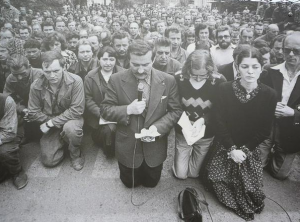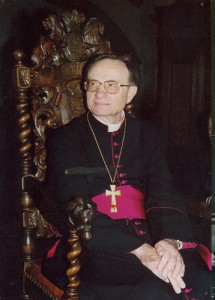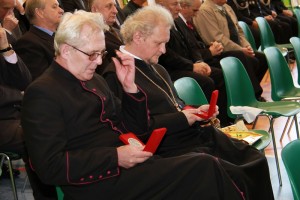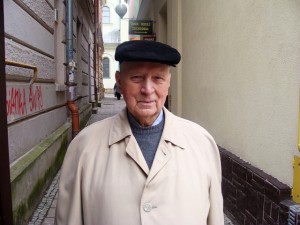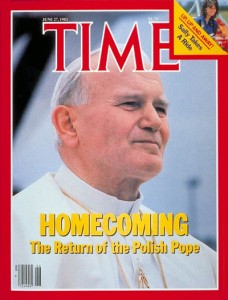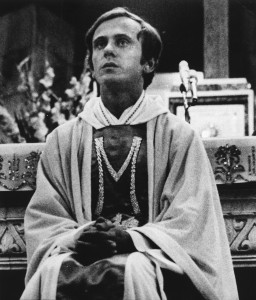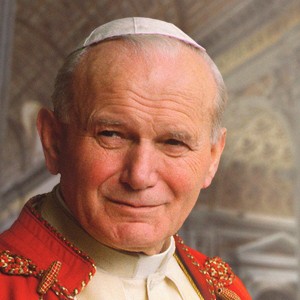By Bartosz Buczynski
Introduction
In the year 1989, after 44 years communism ended in Poland. The peaceful transition was forced by a nation of people who resisted the government to a point that it could not rule anymore. This populous movement was run underground and had agents in all spheres of society. People rich, poor, and with all levels of education demanded change. Naturally, being an extremely catholic country, the church and its representatives could not stay neutral in this struggle. While amongst most areas of the Soviet block and such Soviet satellite states as Czechoslovakia the local governments were able to push religion almost entirely out of the public sphere, however, the religious traditions made this impossible in Poland. With such people as cardinal Stefan Wyszyński and Karol Wojtyła who later became pope John Paul II in 1978
being prominent figures not only in the catholic church but also in their home country. The most celebrated heroes of the Polish struggle against communism such as Lech Wałęsa looked towards their faith and often turned to prayer in the most bleak of times. Despite repression from the communist leaders, the Catholic religion and its representatives definitely played role in the Polish struggle against communism.
This research guide looks at both polish and english language sources concerning the involvement of the Catholic church with the greater Polish struggle against communist rule. With a mixture of primary sources from the time period and secondary sources that can analyze the events with some more perspective, this guide will consider the extent in which the catholic church resisted the communist regime. Looking at case studies of religious figures who also got involved with politics such as Piotr Gołębiowski. Also, considering how the topic is looked at in pop culture through movies and literature. The vast variety and spectrum of the sources allows for a balanced and fair analysis of the time period and a dive into the true motivations of both sides to the struggle.
General Overview
When studying a topic, it is vital to get a bigger picture before narrowing it down further later. These sources provide some necessary background information on how and way the opposition to the communist regime began and how Solidarity started. They also explain the ways in which the catholic church interacted with Solidarity and the possible what events made it possible for that relationship to change over time.
LABA, ROMAN. The Roots of Solidarity: A Political Sociology of Poland’s Working-Class Democratization. Princeton University Press, 1991.
This entire book and especially chapter 6 offer the background behind Solidarity and some of the motivations of their founders. It goes in depth on explaining how it could grow to encompass people from all kinds of social backgrounds and ways of life. It is important to understand the values of the people beginning the resistance to communist rules in order to see how they compare and contrast with the Catholic church.
Stanley, John. “Sex and Solidarity, 1980-1990.” Canadian Slavonic Papers / Revue Canadienne Des Slavistes 52, no. 1/2 (2010): 131-51.
In this paper found in a more broader collection, Stanley discusses such events as the Vatican II council and how it gave power for the Polish Bishops to reach beyond the church when discussing issues. This is valuable as it explains a role that the Catholic church had in resisting communist rule. He explains that the churches ability to contact the world outside Poland gave them the ability to keep a contact with the western world. This paper also explains other ways how the church played a role. For example serving as refuge for the many haunted by the secret police or simply to care for the great majority of Roman Catholics in Solidarity.
Higginson, Paul. “The Vatican and Communism from ′Divini Redemptoris′ to Paul VI: Part 2.” New Blackfriars 61, no. 720 (1980): 234-44.
This journal article provides plenty of background on the Catholic Churches view of socialism and communist regimes as a whole. Where most of my other sources concentrate on the situation in Poland, this article provides a broader picture that is valuable as it can be adapted to the Polish condition as well. The article goes in depth into the Vatican council and discusses its decision making and factors that it concentrates most when making decisions.
Alvis, Robert E. White Eagle, Black Madonna: One Thousand Years of the Polish Catholic Tradition. New York: Fordham University Press, 2016.
This entire book is dedicated towards the rich history of the Polish church, with each chapter dedicated to a specific time period or crucial event. However, for our purposes chapter 9 is one with the most value. This chapter explains the difficulties of setting up of the Polish church after World War II. It discusses the difficult task that Cardinal Wyszyński had to undertake when setting up a church in an anti-religious state. This whole book provides a background to the long history of Catholicism in the nation which makes it easier to understand how much it affected everyday Polish life. While chapter 9 places all of that background into our researched time period.
Catholic view on Communism and Socialism
This website does a thorough job in explaining how many of the catholic values are not represented in the very essence of communism. It shows why the Catholic church was a natural opposition to communism in Poland as the very religious nature of the Polish population created millions of ideological opponents. This website offers a good background to the very core of the conflict.
Polish Language printed sources
Using my ability to fluently speak Polish and access to Polish libraries that many students in the United States would not be able to allows me to use sources not available to others. I found all these books in Poland and are valuable because these authors lived through the times discussed.
Ryszard Terlecki, Polska w niewoli 1945-1989 (Krakow: Wydawnictwo AA s.c., 2015)
Title can be translated to “Imprisoned Poland in the years 1945-1989. This book is a vital source of a general overview of the situation within the time period studied. It has chapters that show how the underground resistance was setup as well as how the government was set up to counter it. Book is written by a Ryszard Terlecki, a graduate of the Jagielonian university during the time of communist rule in the 70’s and an active politician in the post communist era therefor shows an interesting perspective of someone who experienced the times first hand.
Most useful section of book discusses the journey of Cardinal August Hlond back from Rome to Poland and the struggles he encountered with the new communist government. It also includes information about Cardinal Wyszyński and Karol Wojtyła and how they had fight to set up the church after the war. The whole book tells the story of Poland under communism in a linear way. In it intertwining the role of the church in many vital events which aids this guide.
Szczepan Kowalik, Władze PRL wobec biskupa Piotra Gołębiowskiego (Radom: Wydawnictwo Encyklopedyczne, 2016)
Title can be translated to “The leaders of the Polish Peoples Rebublic (PRL) against bishop Piotr Gołębiowski”. This book is important to this research as it shows the attitude and actions of the ruling power towards the catholic church in the country and religion in general. It goes into the structure of how the government planned to systematically eliminate the power of the church through “Salami tactics” or slowly eliminating the church from different spheres of life.
The book most notably concentrates on the story of Bishop Piotr Gołębiowski which as the author states himself is not the most widely known representatives of the church from that time. In the very beginning the author states the hostile nature of the state towards the church and explains how the church managed to stay relevant despite it. Through the example of the Bishop we learn about how the church was set up from the ground up and how individual representatives acted to keep people loyal to their religion.
Mateusz Wyrwich, Kapelani Solidarności Tom II 1980-1989 (Lublin: Oficyna Wydawnicza RYTM, 2007)
Mateusz Wyrwich, Kapelani Solidarności Tom III 1980-1989 (Oficyna Wydawnicza RYTM, 2009)
Both Books were written by Mateusz Wyrwich who was a journalist for the journal “Solidarity Weekly” between the ages of 1981 to 1989. This means that he was in the midst of the conflict and provides an interesting perspective on the topic. These books serve a multitude of case studies to analyze the ways in which the church was a part of the solidarity movement to overthrow the communist rulers. Titles can be translated to “Chaplains of Solidarity Volume II 1980-1989” and “Chaplains of Solidarity Volume III 1980-1989.”
Each chapter analyzes a different priest or some sort of church representative and their role in Solidarity and the opposition to the status quo as a whole. These case studies are valuable as they provide in depth information about individual agents to the movement instead of just basic facts. It provides a more behind the scenes view of how Solidarity worked with the church.
Notable case studies from books
These books provide multiple examples that enhance this guide, here are some notable once.
Father Stanisław Bogdanowicz
Provides the example of a role that the catholic church had when fighting the regime. This priest was not
noticed by the government as being a great threat and was not as active as some of the more famous priests as father Popiełuszko. However, as the author of this book states, he is an example of a person who worked to provide like minded people a place to go and discuss their feelings by holding anti communist sermon and teaching the youth. He shows a good example of a way in which priests could fight the status quo by working to keep religion relevant in all spheres of life which was exactly what the regime wanted to stop.
Father Eugeniusz Dryniak
This priest offers an example of someone who grew up knowing that he wants to fight he regime. The author of the book tells the story of how the priest felt he became a priest only to have a voice in this struggle. Father Dryniak is shown is this book as being a voice in his local community and bringing many people to listen to his sermons and provide inspiration. As well as his underground work with Solidarity during the time of the martial law in 1981. This priests provides an example of another way in which the church helped fight communism.
Father Adam Sudoł
Sudoł also fills one chapter amongst the other notable Solidarity clergymen. His story expands our
understanding of the experience further as this priests is older and grew up in free Poland in the interwar years. His memory of the way things were give him an interesting perspective on the situation. He is also one who has to face backlash from the government. The author of the book describes how the government would intimidate Sudoł many times, for example by throwing bricks through his window on a few occasion. This case study provides a deeper view in the way a simple clergymen who would consistently anger the authorities.
Primary Sources
These sources are raw examples of the way in which catholic representatives handled saw and spoke about the regime at the time. The analysis of these documents is left for anyone to make and come up with their own assumptions.
Transcript of Pope John Paul II’s speech given on victory square in Warsaw on 2 June, 1979.
The message given by the head of the catholic church who happens also to be Polish on his first visit back to the nations capital are vital as they represent the official stance of the catholic church. This speech was seen by millions of people and showed an inability for the communist regime to stop a major Catholic gathering showing their struggle in limiting the influence of the church which was their goal.
Recording of Father Jerzy Popiełuszko’s sermon for the nation on the 29th of January 1984
Popiełuszko became a symbol of the church and its resistance to the regime as he became a martyr after getting murder by police later that year in 1984. These sermons held by Popiełuszko were always attended by a multitude of people and were a voice that consistently bugged the regime.
Original issue of Time Magazine from John Paul’s second visit back to Poland
The fact that the Popes visit back to Poland makes the cover of such a popular and respectable magazine as Time puts the magnitude of these event in perspective. Rarely do the popes visit carry enough interest to become the center of a magazine issue. This shows how the visit of Pope John II to his native nation meant more than just a religious trip as it was also going against the wishes of the government to be seen as religious. This issue shows that Polands struggle with communism was a the center of world attention especially following the creation of Solidarity in 1980 and the imposition of martial law in 1981. The return of the Pope seemed a natural response of the head of the church to the dire situation of the faithful in his native country.
Segel, Harold B. “Adam Michnik: (b. 1946).” In The Walls Behind the Curtain: East European Prison Literature, 1945–1990, 247-49. University of Pittsburgh Press, 2012.
The entire book book is not greatly relevent to this topic. However, a chapter of it is an example of a primary source that greatly adds to understanding. It is letters written by Polish journalist and Solidarity member Adam Michnik. In these translated letters he discusses the death of Popiełuszko and extends it to the rest of the church. He discusses how important the church is to the people and maintaining hope. He also mentions how important the Popes visit was in lifting the spirits of the nation. Such a personal account from an important member of Solidarity is valuable as it shows the inner workings of anti-communist movement in Poland and its ties to the church.
Letter from solidarity activist, Andrzej Stalmachowski to cardinal Józef Glemp about round table talks in 1989
This letter is valuable as it shows the difficult relationship that Solidarity had with the Catholic church. On one hand the church was seen as an ally to Solidarity that shared the same goals and beliefs while on the other the church had to be a fair moderator between the opposition and the regime. This letter is significant as it shows how the church was always involved in the process of abolishing communism as even the highest church officials in the country as Cardinal Glemp were kept up do date with the events.
Father Jerzy Popiełuszko
Because of his status as a symbol of resistance, father Popiełuszko was secretely assasinated by the security police. This was because he was becoming to strong of a anti-communist voice for the regime to accept and therefor had to get rid off. His value and affect on the nation was proved by the 250,000 that attended his funeral. This story is essential to examine in detail as it is the most prominent priest during this time period. The way the government handled his presence also shows the desperation of the authorities late on to maintain control at all costs necessary.
VERMAAT, J. A. EMERSON. “The Polish Secret Police and the Popieluszko Case.” Journal of Church and State 28, no. 2 (1986): 249-67.
This journal shows valuable insight into the long history of harassment that Priest Popiełuszko had to endure from the secret police and the government. It shows his unrested resolve for his cause that he ended up giving his life for. It goes in depth in the planning by the police of what to do with the priest and even offers a few possible solutions that the government had drawn up.
Beyer, Gerald J. “A Theoretical Appreciation of the Ethic of Solidarity in Poland Twenty-Five Years after.” The Journal of Religious Ethics 35, no. 2 (2007): 207-32.
The section in this scholarly journal shows how Popiełuszko was a good representation of the values of Solidarity and the way they were trying to accomplish what they wanted. It adds backstory to the reasoning behind his martyrdom and shows how it is rooted in Polish history. This source adds depth to the thinking behind many of the ideals that the communist opposition such as Popiełuszko and solidarity held and why they did the things they did.
Cardinal Stefan Wyszyński
The leader of the Polish church for the greater majority of its time under communist rule, Cardinal Wyszyński is credited with upholding the church during the era. He was know for his stance against the totalitarian regime and for his accomplishments is now often referred to as “Primate of the Millenium”. Wyszynski is also important as is credited with persuading Karol Wojtyła to accept his nomination and become Pope John Paul II.
PACZKOWSKI, ANDRZEJ, MALCOLM BYRNE, GREGORY F. DOMBER, and MAGDALENA KLOTZBACH, eds. From Solidarity to Martial Law: The Polish Crisis of 1980–1981. Central European University Press, 2007.
This entire source is useful to this study as it provides valuable primary sources from the perspective of the russian Politburo meetings that led to the imposition of martial law in 1981 as well as other documents relating to the era. However, document 3 is of the most value to this research as it shows Cardinal Wyszyński’s sermon given in Jasna Góra following the outbreak of strikes in 1980 with comments from the authors. This source is valuable as it shows the churches opinion of the strikes as Cardinal Wyszyński was the highest ranking official in the Polish church at the time. The source shows a particular side of the churches outlook on the protest not always discussed. As Wyszyński shows his understanding of the strikes however, does not give his full support as is fearing an escalation of force and a tragedy in the nation. Not backing up the people striking as perhaps expected.
KOSMICKI, STEPHEN. “THE LEGACY OF POLAND’S “IRON CARDINAL”” The Polish Review 30, no. 4 (1985): 445-48.
This section from the Polish review discusses the importance of Stefan Wyszyński to the Polish nation during a time of desperation and unrest. Kosmicki portrays Wyszyński as always trying to keep a balanced approach trying to appeal to both sides of the conflict to stay calm and not escalate the conflict. This journal article also gives insight into the mentality of the Polish Primate. As it explains how the Cardinal was inspired by the works of legendary Polish author from the 19th century Henryk Sienkiewicz. He was inspired by the stories of old defenses of the Catholic tradition in Poland and felt like he was responsible for the continuation of that tradition. This source is valuable as it shows that the official leader of the Catholic church was not concentrated on simply leaving communism as he also feared capitalism. But rather to keep up the religious traditions and maintain peace.
GACKA, BOGUMIL. “The Personalism of Cardinal Stefan Wyszyński.” The Pluralist 4, no. 1 (2009): 85-92.
This journal article discusses the most important events during the Cardinals reign as primate of Poland. It analyzes how his religious beliefs about family and the nation and the role that both should play in a persons life affected his decision making. This source is valuable as it roots back the churches conflict with communism to faith as we understand how communist ideals went against catholic ones. This makes us understand why the church was a natural enemy of the regime.
Pope John Paul II
When Karol Wojtyła became Pope in 1978 he immediately became the most famous person in the country. The success and popularity of his return trips to his home country as the head of the catholic church showed how much the regimes attempt to limit the influence of religion was not working.
Appleby, Scott. “Pope John Paul II.” Foreign Policy, no. 119 (2000): 12-25.
Appleby discusses how Karol Wojtyła’s upbringing made him the perfect leader of the church during the Polish struggle against communism. He talks about how important his polish heritage was and how it was strengthened by the need to preserve it during the German occupation during World War II. Overall, this article is valuable as it shows how and why the Pope wanted to use his authority to cause change in Poland.
Kraszewski, Gracjan. “Catalyst for Revolution Pope John Paul II’s 1979 Pilgrimage to Poland and Its Effects on Solidarity and the Fall of Communism.” The Polish Review 57, no. 4 (2012): 27-46.
This article places Pope John II as the catalyst and one of the main factors that caused the fall of Communism in Poland. It marks his return to the country in 1979 as a time when the Polish people got some hope that change can happen. The author divides the article into three major ways in which John Paul II affected the Polish peoples resolve for change. He explains how he altered the way people portrayed nationalism, work, and faith and how this led to changes. This article is valuable as it show how the leader of the church directly effect the struggle against communism.
PETRI, THOMAS. “The Moral Theology of Karol Wojtyła.” In Aquinas and the Theology of the Body, 92-126. Washington, D.C.: Catholic University of America Press, 2016.
This particular chapter in the the book by Thomas Petri offers an inside into the Popes mentality. It examines the things that affected the Popes belief system and what created it. Petri discusses the other thinkers that the Pope took from when creating his own moral background. Connecting back this chapter about Wojtyła to the rest of this book about Aquinas in explaining how the Pope understood religion and what it stood for. This is useful as it explains why the Pope acted as he acted and what he could see as harmful in the communist ideology.
